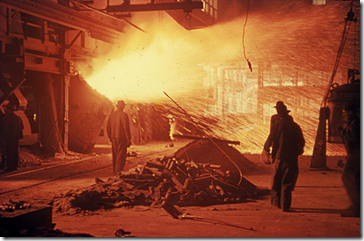 Part 1 of a 3 part series. What differentiates the industrial, digital, social eras, and why is it important? These three terms describe periods of recent history each with characteristic signatures for thinking, leadership and innovation, for their time. As I use these terms more and more, to explain observation, it’s worth defining them.
Part 1 of a 3 part series. What differentiates the industrial, digital, social eras, and why is it important? These three terms describe periods of recent history each with characteristic signatures for thinking, leadership and innovation, for their time. As I use these terms more and more, to explain observation, it’s worth defining them.
Historical context reveals how thinking, leadership, innovation and other domains have shaped our interpretation and understanding of the future.
So, there will likely be disagreement. That’s why you can comment on my blog. However, a stake must first be driven in the ground, before it can be moved.
Part one, my perception of the industrial era, follows
The Industrial Era
The industrial era, or industrial age, started around 1880 with the century-long mass adoption of mechanization. Some aspects do (and should) persist today. Technology primarily automated manual labor such as the transition from blacksmith to steel mill.
In terms of business and commerce, Nilofer Merchant points out in her recent work that industrial era companies created value by and for the institution. Innovation was largely incremental and become progressively unremarkable near the end of the era. Industrial era companies were closed and isolated. They ruthlessly competed in hopes to eliminate the other.
Business to Consumer-ism
Organizations were stagnant, and rigidly structured into silos. Management measured productivity in terms of piecework throughput. Companies were managed by CEOs in ivory towers, and managers limited communication and controlled thinking to drive out variation, and increase six-sigma quality.
The seminal stages of consumerism began in the industrial era. While the concept of “built to last” was used by marketing, the statement was at odds with an inevitable future of throw-away consumption. The economic conversation was one way, from industry and business, to markets and consumers.
Education, Management, Labor
In many ways, industrial era companies were iconic, persistent institutions we still know of today. Standard Oil in energy, JP Morgan in banking, US Steel and Westinghouse lead by leaders with equally iconic names, come to mind. It was a time defined by a rigid educational system that killed free thinking to produce an automatous labor force to make things in factories, in a monotonous, routine manner without actively using individual intelligence – and in particular, never to question management.
Industrial, Digital, Social
Up next, tomorrow: The Digital Era.
To Ponder
For what it’s worth, when I was in high school, I studied to be a machinist. I learned how to work metal with the lathe, milling machine and grinder. My artisan hand could work iron by fire on the anvil, but my destiny was to work for the local bearing manufacturing company. Reluctantly entering college a year after my friends, I majored in geology, and learned geophysics to understand the value chain for natural resources (oil, gas, coal, and commercial grade ore-deposits) that fueled the industrial age. In a strange set of events, I’ve experienced the Industrial Era, up to my own elbows.
Leave a comment, and share how you have experienced the industrial era. How would you further define it in the context for the three eras for this series?










[…] Part 1 of 3. What differentiates the industrial, digital, social eras? Why is it important? 3 terms provide context to understand the era we live in. […]
A byproduct of the industrial age was collective intelligence which created the union which has altered our “Dependency Ratio” http://www.gladwell.com/2006/2006_08_28_a_risk.html.
Yes! That Gladwell piece in the New Yorker is a profound read. We’re still figuring this one out – as my note above said that “Some aspects do persist today.” We still make big heavy things that require labor.
[…] Industrial, Digital, Social. 3 eras defining our time. […]